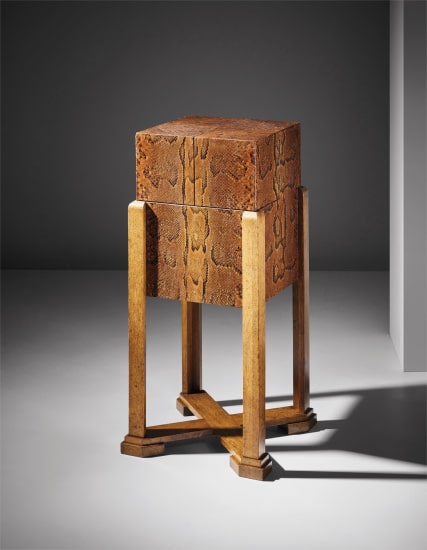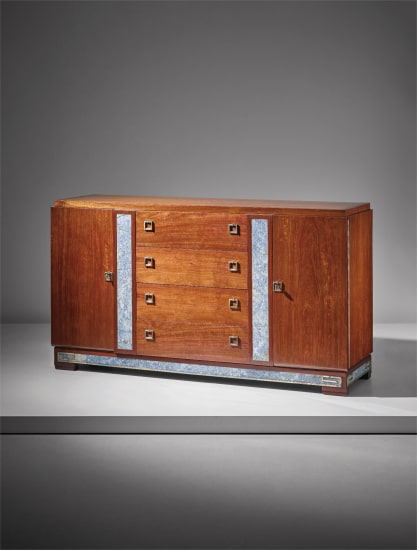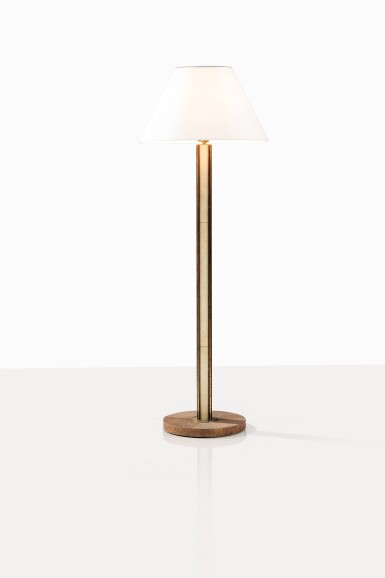Property from a Private European Collection Marcel Coard Important Canapé Gondole circa 1925 Carved Indian rosewood, Indian rosewood-veneered wood, brass, linen velvet. 92.3 x 247.5 x 87 cm (36 3/8 x 97 1/2 x 34 1/4 in.) Underside impressed twice with M. C. COARD and designer's perroquet mark.
Provenance Private collection, The Hague Acquired from the above by the present owner, 2010 Literature FOR THE DOUCET EXAMPLE Jean-François-Revel, 'Un temple de l'art moderne, l'appartement de M.J.D.', Femina, January 1925, p. 30 for the canapé in situ André Joubin, 'Le studio de Jacques Doucet', L’Illustration, May 1930, p. 17 for the canapé in situ Jean-François-Revel, 'Jacques Doucet, couturier et collectionneur', L'Œil, December 1961, p. 47 for the canapé in situ Pierre Kjellberg, 'Art Déco: Les artistes d'avant-garde Marcel Coard, Djo Bourgeois', La Gazette de l'Hotel Drouot, 12 December 1980, p. 40 Pierre Kjellberg, Art Deco, les Maitres du Mobilier, Paris, 1981, p. 11 for the canapé in situ Alistair Duncan, Art deco furniture, the French designers, New York, 1984, p. 21, fig. 7 François Chapon, Mystère et splendeurs de Jacques Doucet 1985-1929, Paris, 1984, p. 224 for the canapé in situ Frederick R. Brandt, 'Art Deco: Patrons and Designers', Apollo, December 1985, p. 461, figs. 2-3 Frederick R. Brandt, Late 19th and Early 20th Century Decorative Arts: The Sydney and Frances Lewis Collection in the Virginia Museum of Fine Arts, Richmond, Virginia, 1985, p. 217, no. 88 Évelyne Possémé, Le Mobilier Français 1910-1930, Paris, 1999, p. 19 for the canapé in situ, p. 185 Victor Arwas, Art Deco, New York, 2000, p. 80 Alistair Duncan, Art Deco, Encyclopédie des arts décoratifs des années vingt et trente, Paris, 2010, p. 10 Amélie Marcilhac, Marcel Coard Décorateur, Paris, 2012, p. 62, p. 63 for the canapé in situ Jean-Louis Gaillemin, Félix Marcilhac, Passion Art Déco, Paris, 2014, p. 73 for the canapé in situ Jared Goss, French Art Deco, New York, 2014, p. 135 for the canapé in situ Jacques Doucet Yves Saint Laurent Vivre Pour l'Art, exh. cat., Fondation Pierre Bergé Yves Saint Laurent Paris, 2015, pp. 30 for the canapé in situ, pp. 66-67 Catalogue Essay Phillips wishes to thank Amélie Marcilhac for her assistance with the cataloguing of the present lot. MARCEL COARD’S ‘CANAPÉ GONDOLE’ Amélie Marcilhac, March 2016 Jacques Doucet the great couturier and patron of the arts, was among the most iconic figures of the Art Deco period. From 1928, his studio on rue Saint-James in Neuilly was a theatre of artistic revolution, as avant-garde in furniture as it was in pictures. His objective was to provide a showcase that would inspire creativity and expression among his protégés. Pablo Picasso’s “Les Demoiselles d’Avignon”, the most telling example, hung above Joseph Csaky’s stairwell and jealously watched over this hotbed of creativity. Marcel Coard was among the elite decorators and artists chosen by this patron; discovered by Doucet in 1914, Coard created for him that year a bombé vitrine in Macassar ebony, ivory, and mother-of-pearl which now resides in the Musée des Arts Décoratifs, Paris. Though Marcel Coard had his own style, the influence of his patron is evident in the works he created for him. As was his way with the great majority of artists working for him, Doucet influenced his commissions with his own style and tastes, going beyond mere sponsor to play the role of guide and master of the arts. Whereas gilding and curves predominated in his studio on the avenue du Bois (his earlier residence), at his studio on rue Saint-James he gave pride of place to primitive art, and their geometric and rustic aesthetic provided new sources of inspiration to the decorators and artisans, allowing them to imagine new revolutionary forms all the while favouring the use of precious materials. In this way, Coard created for the couturier a work that was the perfect synthesis of these two influences. Around 1924, he created the famous canapé gondole that was displayed on the avenue du Bois. It was reproduced in 1925 for an article in Fémina, before being installed in the provocative rue Saint-James salon in 1928. This Indian rosewood canapé, inlaid with two rows of ivory and entirely covered in strips of wood carved to resemble basketry, is a
Property from a Private European Collection Marcel Coard Important Canapé Gondole circa 1925 Carved Indian rosewood, Indian rosewood-veneered wood, brass, linen velvet. 92.3 x 247.5 x 87 cm (36 3/8 x 97 1/2 x 34 1/4 in.) Underside impressed twice with M. C. COARD and designer's perroquet mark.
Provenance Private collection, The Hague Acquired from the above by the present owner, 2010 Literature FOR THE DOUCET EXAMPLE Jean-François-Revel, 'Un temple de l'art moderne, l'appartement de M.J.D.', Femina, January 1925, p. 30 for the canapé in situ André Joubin, 'Le studio de Jacques Doucet', L’Illustration, May 1930, p. 17 for the canapé in situ Jean-François-Revel, 'Jacques Doucet, couturier et collectionneur', L'Œil, December 1961, p. 47 for the canapé in situ Pierre Kjellberg, 'Art Déco: Les artistes d'avant-garde Marcel Coard, Djo Bourgeois', La Gazette de l'Hotel Drouot, 12 December 1980, p. 40 Pierre Kjellberg, Art Deco, les Maitres du Mobilier, Paris, 1981, p. 11 for the canapé in situ Alistair Duncan, Art deco furniture, the French designers, New York, 1984, p. 21, fig. 7 François Chapon, Mystère et splendeurs de Jacques Doucet 1985-1929, Paris, 1984, p. 224 for the canapé in situ Frederick R. Brandt, 'Art Deco: Patrons and Designers', Apollo, December 1985, p. 461, figs. 2-3 Frederick R. Brandt, Late 19th and Early 20th Century Decorative Arts: The Sydney and Frances Lewis Collection in the Virginia Museum of Fine Arts, Richmond, Virginia, 1985, p. 217, no. 88 Évelyne Possémé, Le Mobilier Français 1910-1930, Paris, 1999, p. 19 for the canapé in situ, p. 185 Victor Arwas, Art Deco, New York, 2000, p. 80 Alistair Duncan, Art Deco, Encyclopédie des arts décoratifs des années vingt et trente, Paris, 2010, p. 10 Amélie Marcilhac, Marcel Coard Décorateur, Paris, 2012, p. 62, p. 63 for the canapé in situ Jean-Louis Gaillemin, Félix Marcilhac, Passion Art Déco, Paris, 2014, p. 73 for the canapé in situ Jared Goss, French Art Deco, New York, 2014, p. 135 for the canapé in situ Jacques Doucet Yves Saint Laurent Vivre Pour l'Art, exh. cat., Fondation Pierre Bergé Yves Saint Laurent Paris, 2015, pp. 30 for the canapé in situ, pp. 66-67 Catalogue Essay Phillips wishes to thank Amélie Marcilhac for her assistance with the cataloguing of the present lot. MARCEL COARD’S ‘CANAPÉ GONDOLE’ Amélie Marcilhac, March 2016 Jacques Doucet the great couturier and patron of the arts, was among the most iconic figures of the Art Deco period. From 1928, his studio on rue Saint-James in Neuilly was a theatre of artistic revolution, as avant-garde in furniture as it was in pictures. His objective was to provide a showcase that would inspire creativity and expression among his protégés. Pablo Picasso’s “Les Demoiselles d’Avignon”, the most telling example, hung above Joseph Csaky’s stairwell and jealously watched over this hotbed of creativity. Marcel Coard was among the elite decorators and artists chosen by this patron; discovered by Doucet in 1914, Coard created for him that year a bombé vitrine in Macassar ebony, ivory, and mother-of-pearl which now resides in the Musée des Arts Décoratifs, Paris. Though Marcel Coard had his own style, the influence of his patron is evident in the works he created for him. As was his way with the great majority of artists working for him, Doucet influenced his commissions with his own style and tastes, going beyond mere sponsor to play the role of guide and master of the arts. Whereas gilding and curves predominated in his studio on the avenue du Bois (his earlier residence), at his studio on rue Saint-James he gave pride of place to primitive art, and their geometric and rustic aesthetic provided new sources of inspiration to the decorators and artisans, allowing them to imagine new revolutionary forms all the while favouring the use of precious materials. In this way, Coard created for the couturier a work that was the perfect synthesis of these two influences. Around 1924, he created the famous canapé gondole that was displayed on the avenue du Bois. It was reproduced in 1925 for an article in Fémina, before being installed in the provocative rue Saint-James salon in 1928. This Indian rosewood canapé, inlaid with two rows of ivory and entirely covered in strips of wood carved to resemble basketry, is a


.jpg)






.jpg)



Try LotSearch and its premium features for 7 days - without any costs!
Be notified automatically about new items in upcoming auctions.
Create an alert